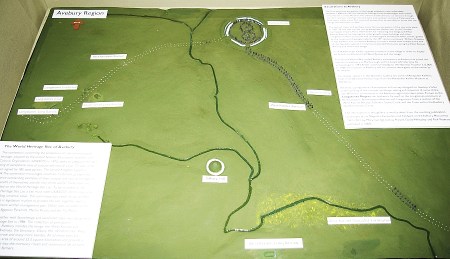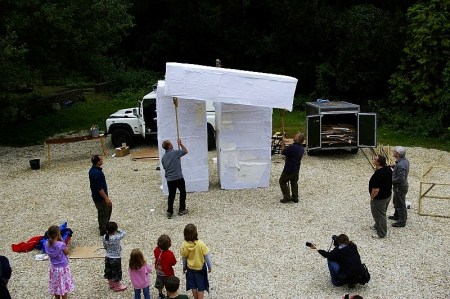
photos by Pete Glastonbury, with permission
Hello again from the amazing Wiltshire Heritage Museum in Devizes. Of course we’re not actually there, but we have a rich fantasy life! Today, thanks to our regular supplier of Afghani-grade Avebury photos, we have two Avebury models to post. Avebury is a very large stone circle in Wiltshire England. We hope you already knew that.
The model above is to be applauded for accuracy and detail. It shows the circle as it might have been in its heyday, with circles and avenues leading from the circle complete. Very nice. We would like it better without the labels, but we understand that in a museum, the point is to communicate knowledge and the labels serve that purpose. 8 druids for this one.
 And then there’s this one, depicting, as it might have been at its height, the entire Avebury region, or nearly so, as it excludes Windmill Hill and, of course, all the ancient crop circles. It includes various barrows, the serpentine avenues (which we discussed here), Silbury Hill, West Kennet Long Barrow, and if you look closely enough there may be a tiny model of Pete Glastonbury walking around taking pictures (or if there isn’t perhaps there should be). This, too, is an extraordinary piece of work, and we award it 8½ druids. We like to see the whole landscape represented!
And then there’s this one, depicting, as it might have been at its height, the entire Avebury region, or nearly so, as it excludes Windmill Hill and, of course, all the ancient crop circles. It includes various barrows, the serpentine avenues (which we discussed here), Silbury Hill, West Kennet Long Barrow, and if you look closely enough there may be a tiny model of Pete Glastonbury walking around taking pictures (or if there isn’t perhaps there should be). This, too, is an extraordinary piece of work, and we award it 8½ druids. We like to see the whole landscape represented!
The Wiltshire Heritage Museum is said to house numerous models of Stonehenge seen nowhere else, the amazing Celtic Cabinet, and, for now, Clonehenge’s favourite exhibition, Inspired by Stonehenge, which includes “a variety of objects, graphics, music and moving images including postcards and guidebooks, clothing, paperweights and snow globes, jigsaw puzzles, horse brasses, toasting forks and even a stamp from the Himalayan kingdom of Bhutan that shows Disney characters Mickey Mouse and Pluto at Stonehenge. There is also a quantity of souvenir china – some more attractive than others. Once visitors have viewed the exhibition they can vote for the item they consider to be in the worst possible taste!” Bold emphasis added by us. People, does it get any better than that?!
Hours and admission fees for the museum can be seen here. Oh, and the site says “Youngsters are encouraged to be ‘Inspired by Stonehenge’, and are invited to send in photographs of their own Stonehenge models for display in the Museum over the summer.” We plan to lean on the museum a little in autumn, to get them to let us post the best–and perhaps the worst–ones they get. And you haven’t seen the last of Wiltshire Heritage Museum on this blog. More in a few days!
 photos by Pete Glastonbury, with permission
photos by Pete Glastonbury, with permission




 And then there’s this one, depicting, as it might have been at its height, the entire Avebury region, or nearly so, as it excludes Windmill Hill and, of course, all the ancient crop circles. It includes various barrows, the serpentine avenues (which we discussed
And then there’s this one, depicting, as it might have been at its height, the entire Avebury region, or nearly so, as it excludes Windmill Hill and, of course, all the ancient crop circles. It includes various barrows, the serpentine avenues (which we discussed  photos by
photos by  Stukeley proposed that the avenues of standing stones, now called Beckhampton and West Kennet Avenues, originally combined with the Avebury circle to form a glyph of a serpent passing through a ring, a traditional alchemical symbol. The head was formed by a circle now called
Stukeley proposed that the avenues of standing stones, now called Beckhampton and West Kennet Avenues, originally combined with the Avebury circle to form a glyph of a serpent passing through a ring, a traditional alchemical symbol. The head was formed by a circle now called  photos by
photos by  The replica at the top of this post, seen in glass on top of the cabinet, is one of the cork models by Henry Browne,
The replica at the top of this post, seen in glass on top of the cabinet, is one of the cork models by Henry Browne, 